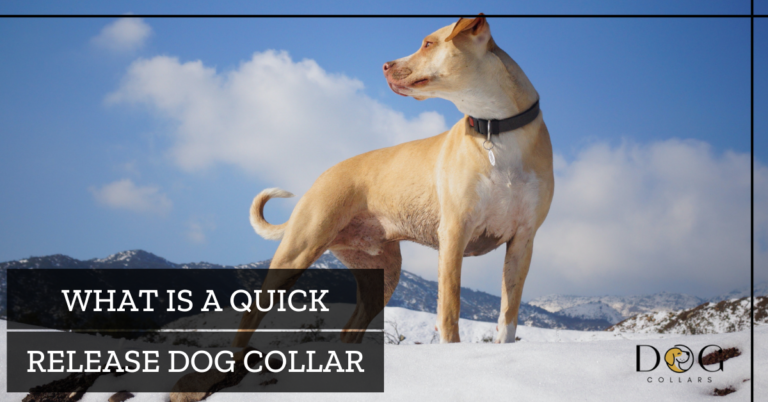How To Put A Pinch Collar On A Dog – 3 Steps Guide
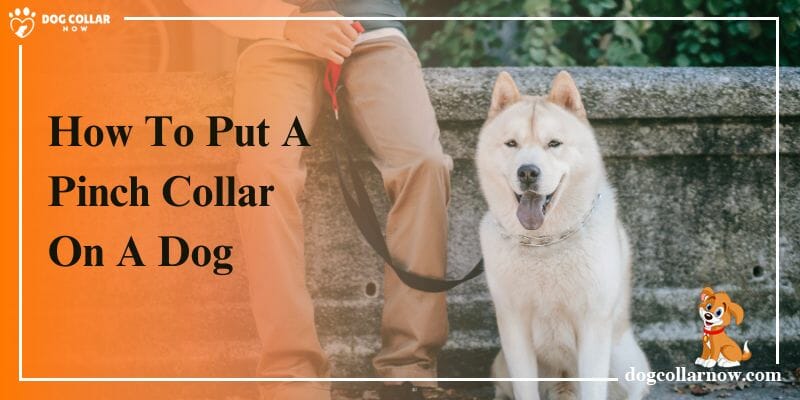
Hey, there fellow dog owners! As someone who loves their furry companion more, I’m always on the lookout for new and effective ways to train and care for my pup.
Now, I know the thought of using a pinch collar on your beloved pup might seem a bit daunting, but trust me, with the right technique and approach, it’s a simple and effective way to control their behavior. So, how do you put a pinch collar on a dog? Well, let me walk you through it.
First off, it’s important to ensure that the collar is fitted correctly. You don’t want it to be too tight or too loose, as this can cause discomfort or even harm to your furry friend. Once you’ve got the fitting right, gently place the collar around your dog’s neck and attach the leash.
I’ll be sharing step-by-step instructions on how to put a pinch collar on your dog and how to use it for effective training. So, stay tuned and get ready to take your pup’s training to the next level!
How To Put A Pinch Collar On A Dog (Step-By-Step Guide)
To put the collar on a dog correctly, follow these simple steps:
1. Size Of Collar:
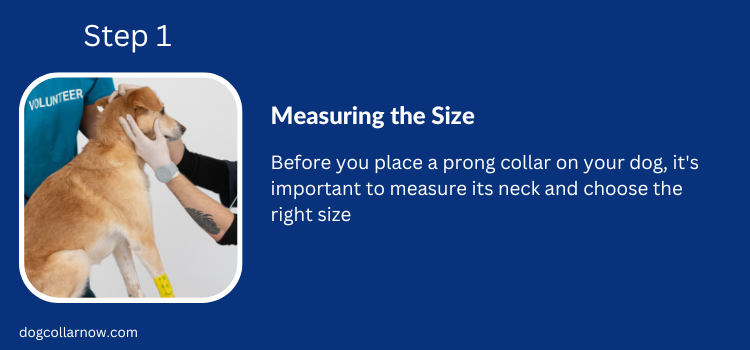
Before you place a prong collar on your dog, it’s important to measure its neck and choose the right size. Properly walking your dog allows them to move comfortably without any discomfort or issues.
2. Fitting The Prong Collar:
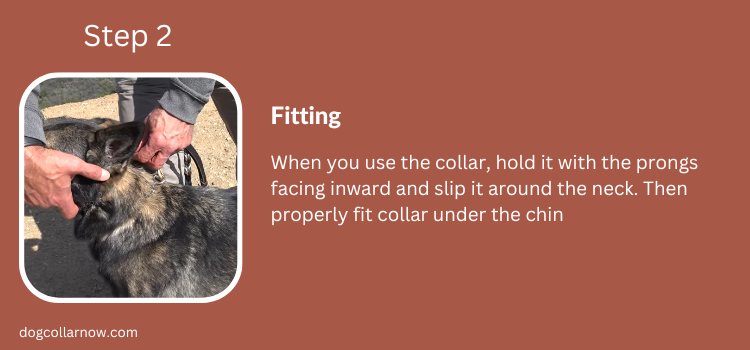
When you use the collar, hold it with the prongs facing inward and slip it around the neck. The properly fit collar under the chin.
3. Fastening Prong Collar:
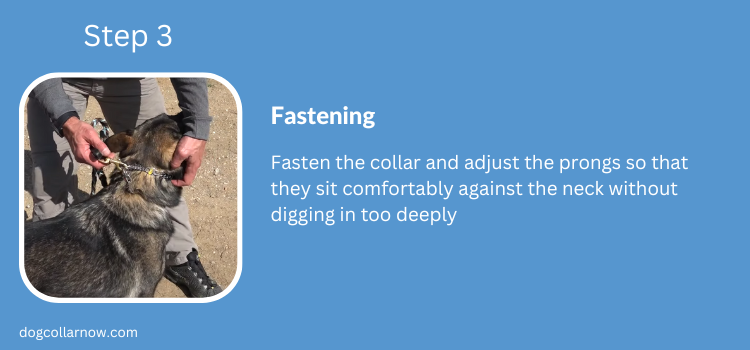
Fasten the collar and adjust the prongs so that they sit comfortably against the neck without digging in too deeply.
Experts recommend using the choke collar under the supervision of a professional dog trainer or behaviorist to ensure its safe and effective use.
Sizing The Prong Dog Collar
When sizing a prong collar, it’s important to ensure that it fits your dog correctly.
A prong collar that is too loose won’t be effective in training your dog, while a collar must not be too tight so that it can be uncomfortable and even harm your dog.
To properly size a dog prong collar,
- Measure the circumference of the neck of your dog with a measuring tape.
- Then, add 2-3 inches to that measurement to find the appropriate collar size.
For example, if your dog’s neck measures 14 inches, a prong collar with a total length of 16-17 inches would be a good fit.
When fitting the collar, make sure that the prongs sit snugly against the neck of the dog, without being so tight that they dig into their skin. You should be able to fit a finger between the collar and your dog’s neck.
Size Of Prongs Collar
Here are some examples of different sizes of prongs that are commonly available on prong collars:
- 1/8-inch prongs: These are the smallest size of spikes available on prong collars. They are best suited for very small dogs with short hair, such as Chihuahuas, Toy Poodles, and other toy breeds.
- 1/6-inch prongs: These are slightly larger than the 1/8-inch spikes and are also suitable for small dogs with short hair.
- 1/4 inch prongs: These are the most common size of prongs and are suitable for most medium-sized dogs with short to medium-length hair.
- 3/8-inch prongs: These prongs are slightly longer than the 1/4-inch spikes and are best suited for dogs with thick coats or long hair, such as German Shepherds, Huskies, and other large breeds.
- 1/2-inch prongs: These are the longest spikes commonly found on prong collars and are best suited for dogs with very thick fur or long hair, such as Bernese Mountain Dogs, Newfoundland Dogs, and other giant breeds.
It’s important to note that the size of prongs you choose for your dog will depend on their individual size, breed, and coat type.
Types And Styles Of Prong Collars
- Classic Prong Collars – These are traditional prong collars that have a chain and a series of prongs for correction. Some examples of classic prong collars available on Amazon are:
- Herm Sprenger Ultra-Plus Prong Teaching Collar
- Coastal Pet Products Titan Easy-On Prong Training Collar
- KONG Training Collar for Dogs
- Martingale Prong Collars – These are combination collars that use both a martingale and prong design for greater control of a large dog. Some examples of martingale prong collars available on Amazon are:
- Mighty Paw Chain Martingale Collar
- KRUZ PET KZA102-02S Martingale Collar with Quick Release Buckle
- Herm. Sprenger Curogan Martingale Collar
- Quick-Release Prong Collars – These collars have a quick-release mechanism for easier on and off. Some examples of quick-release available prong collars on the market are:
- Downtown Pet Supply Quick Release Prong Training. Collar
- GoodBoy Quick-Release Choke Collar for Dogs
- Herm. Sprenger Quick Release Prong Collar
- Plastic Prong Collars – These collars use plastic prongs instead of metal for a gentler correction. Some examples of plastic prong collars available on Amazon are:
- The Company of Animals Halti dog training Collars
- PetSafe Gentle Leader Head Collar with Training DVD
- Herm Sprenger prong Neck-Tech Sport Collar with Buckle
- Slip Prong Collars – This type of collar combines the design of a slip collar and a prong collar for added control. Some examples of slip prong collars available on Amazon are:
- HS Sprenger Ultra Plus Prong Collar with Center Plate and Quick Release
- CollarDirect Dog Prong Training Collar
- Herm Sprenger pinch collar Curogan Slip
Dead Ring vs. Live Ring
When using a prong collar, you can attach the leash to the live ring or dead ring. Here are some key points:
Dead Ring:
- The stationary ring is located at the base of the prong collar
- Offers limited control over the dog’s behavior
- A handler can only control the dog’s direction and cannot adjust the level of pressure on the collar
Live Ring:
- Moving ring that can slide around the collar
- Offers more control over the dog’s behavior
- The handler can adjust the level of pressure on the collar by moving the live ring
- Allows the handler to apply more or less pressure to the collar, depending on the situation and the dog’s behavior.
Recommended Safety System for All Prong Collars
Here are some recommended safety systems that should be followed:
- Proper Fit: A properly fitted collar may prevent your dog from slipping out of its leash and running away. Ensure the prong dog collar fits snugly but not too tight or loose.
- Use Properly: Avoid using it as a punishment tool, jerking excessively.
- Gradual Introduction: Introduce the collar gradually if you don’t want to hurt your dog.
- Consistent Monitoring: Watch for signs of discomfort or distress, and stop using the collar if necessary.
- Regular Inspection: Check the collar regularly for damage or wear and tear so that the neck of the dog may not hurt.
- Proper Use of Safety Mechanism: Understand how to use fast-release or backup collars.
- Professional Assistance: Seek guidance from a professional trainer or vet if needed.
How to Train Your Dog With a Prong Collar
When it comes to prong collar training, it’s important to take the time to properly introduce the collar to your dog. Here we have some points to discuss:
- Take the collar and ensure that collar is properly sized and positioned high up and chain dog collars properly, just behind the ears
- Use another type of training such as positive reinforcement techniques to reward good behavior, and only apply pressure to the collar when necessary
- Avoid pulling excessively on the collar or using it as a punishment.
- Seek guidance from a professional dog trainer to learn how to use the collar properly and safely.
- Practicing patience and consistency in training your dog with the prong collar.
Dispelling Misconceptions About Prong Collars
To avoid causing harm or discomfort to your dog, it’s crucial to properly use any training tool, including a prong collar. So, you may have heard some things about prong collars that make you feel uneasy or unsure about using them on your dog. But did you know that some of these things are actually myths?
- Myth: Prong collars are cruel and hurt dogs.
- Fact: Prong collars provide gentle and natural correction for your dog’s behavior.
- Myth: Prong collars are only for aggressive dogs.
- Fact: Prong collar is a safe option and can help any dog with training, regardless of their aggression level.
- Myth: Prong collar is humane as long as it is fitted properly.
Fact: Unfortunately, this is a false statement that’s been perpetuated by cruel trainers. Even properly fitted prong collars penetrate into the delicate skin around the neck, causing serious harm to the thyroid, esophagus, and trachea.
As a responsible dog owner, it’s important to do your research and learn the facts before making any decisions about which collar to use for your furry friend.
Are Prong Collars Humane?
In terms of the question of whether prong collars are humane, there is no easy answer.
Using a prong collar on a dog during walks can provide better control, but it should only be used as a training tool and fitted correctly. While some dogs may respond well to the use of prong collars, others may experience discomfort, pain, or even injury. It ultimately depends on the individual dog, its temperament, and its training needs.
Mother Dogs Use Neck Bites For Correction And Teaching
Have you ever wondered how mother dogs communicate with and teach their puppies? It turns out they use a natural and effective method – gentle neck bites for correction and teaching.
- Mother dogs use a variety of ways to communicate with and teach their puppies, including correcting them with a gentle bite to the neck.
- This is a natural and effective way for dogs to communicate with each other and help puppies learn what behavior is acceptable and what isn’t.
- As dog owners, we can learn from this natural behavior and use gentle, firm commands and positive reinforcement to teach our dogs what we expect from them.
- Consistency and clear communication are important in helping our dogs learn and thrive.
A Special Note About Aggressive Dogs
If you have an aggressive dog, it’s important to work with a professional trainer who has experience with aggressive dogs.
It’s important to remember that if you do decide to use prong collars, you should never use them as a permanent solution. Some training methods may not be appropriate for crazy dogs, so positive training techniques may be more effective. Aggressive behavior in dogs is a serious issue that requires professional guidance to address.
Conclusion
Putting a prong collar correctly on a dog requires patience, care, and proper technique. It is important to understand the purpose of the collar and to use it only as a training aid, not a punishment tool.
Remember to introduce the collar gradually, use positive reinforcement, and seek guidance from a professional trainer if needed. With the right approach, a prong collar can be a useful tool for teaching your dog to walk calmly on a leash and obey basic commands.
By following this step by step guide on how to put a pinch on a dog collar and treating your dog with respect and compassion, you can establish a strong and healthy relationship with your dog.
Frequently Asked Questions:
Do vets recommend prong collars?
Vets generally do not recommend the use of prong collars as they can sometimes be used incorrectly by untrained handlers and cause harm to the dog. Ultimately, the decision to train with a prong collar should be made with care, considering all options and seeking professional advice.
Where should a prong collar sit on a dog?
It is important to ensure that the collar should fit snugly around the neck, just below the ears. The collar should not be around the dog’s throat but rather around the mid-neck. It is essential to adjust the collar length to fit your dog’s specific size and shape so that it is effective in training but also safe and comfortable for your furry friend.
Can a dog wear a prong collar all the time?
Wearing the prong collar all the time is not recommended. A prong collar is a training tool that should only be worn during training sessions or walks. Leaving the collar on for extended periods can harm your dog. The collar can only be used to communicate with your dog effectively, not to cause any harm to the dog. After use, it should be removed and replaced with a regular collar or harness.
Do prong collars make dogs aggressive?
There is a common misconception that using a prong collar can make a dog aggressive. However, this is not entirely true. When using the prong collar, it is important to use it effectively with your dog to avoid any harm to your dog. Keep in mind it is a tool used for training and behavior modification and should be used under the guidance of an expert.
When Should I Start Using a Prong Collar?
The use of a prong collar should only be considered after other training methods have been attempted and failed. Make sure the collar is used under the guidance of a professional dog trainer who can teach you how to use the collar properly and safely otherwise the collar can cause damage
How to stop your dog from pulling the leash?
If your dog pulls the leash like a sled dog with a flat collar is not very humane! Start with placing the collar around the neck of your dog properly. A well-fitted collar is vital to ensure that your dog doesn’t slip out of it during the walks and helps to stop your dog from pulling the leash.
How tight should a spiked collar be on a dog?
It’s recommended that you try to fit a prong collar before buying one to ensure that it’s the right size for your dog. As a general rule, you should be able to fit two fingers comfortably between the collar and the neck of the dog. If you can’t, it’s too tight, and if you can fit more than two fingers, it’s too loose. Remember, a properly fitting collar is a vital component of effective training.
Should dogs sleep with collars off?
To ensure your dog’s safety and comfort, it’s recommended to remove their collar at night as an alternative to a prong collar, which could cause harm or accidents, such as the collar getting caught or tangled up.
How many hours can a dog wear a collar?
Prong collars are not meant for extended wear, as they can cause discomfort and even pain to your dog. If you notice any signs of irritation, such as redness or rawness around the neck area, it’s important to remove the collar and give your dog a break. In addition to being uncomfortable, wearing a collar for too long can lead to friction, which can cause hair loss and skin irritation.






